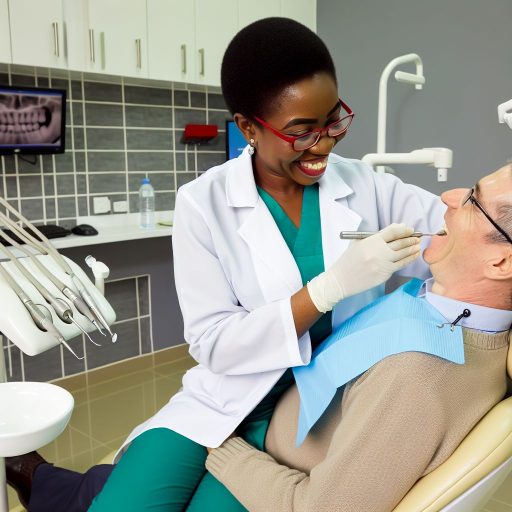Introduction
Staying updated on research in dentistry is crucial for providing high-quality care to patients.
Keeping up with the latest advancements in restorative dental procedures ensures that dental professionals are equipped with the most effective techniques and technologies to deliver optimal outcomes for their patients.
Recent studies on dental materials
Advancements in dental materials have revolutionized the field of restorative dentistry.
Researchers are constantly exploring new materials and techniques to improve the quality and longevity of dental restorations.
Let’s take a closer look at some of the latest research in this area.
Analysis of new materials used in restorative dentistry
One of the key focuses of recent research in restorative dental practices is the analysis of new materials that can be used for dental restorations.
Traditional materials like amalgam and composite resin have been widely used in the past, but newer materials offer enhanced properties and improved aesthetics.
- Nanocomposites: Researchers are investigating the use of nanocomposite materials, which are a combination of nanoparticles and conventional dental materials. These materials offer increased strength, improved wear resistance, and better esthetics compared to traditional composites.
- Bioceramics: Bioceramic materials have gained popularity in recent years due to their biocompatibility and ability to stimulate tissue regeneration. These materials are particularly useful for endodontic procedures and can improve the success rate of root canal treatments.
- Amorphous calcium phosphate (ACP): ACP is a bioactive material that can release calcium and phosphate ions, promoting remineralization and repair of damaged tooth structure. Research has shown that ACP-based materials can help prevent secondary caries and improve the longevity of dental restorations.
Benefits of using advanced materials for dental restorations
The use of advanced materials in restorative dentistry offers numerous benefits for both patients and dental professionals.
These materials provide improved mechanical properties, better aesthetics, and enhanced biocompatibility, leading to more successful and long-lasting dental restorations.
- Increased durability: Advanced materials like nanocomposites and bioceramics offer superior strength and wear resistance, making them more durable than traditional materials. This results in longer-lasting restorations that require less frequent replacement.
- Enhanced aesthetics: New materials allow for better color matching and blending with natural teeth, leading to more aesthetically pleasing restorations. This is particularly important for front teeth restorations, where appearance plays a significant role.
- Biocompatibility: Advanced materials are designed to be biocompatible, minimizing the risk of allergic reactions or adverse tissue responses. This ensures better patient comfort and overall success of the restoration.
The latest research in restorative dental practices is focused on exploring new materials and techniques that can improve the quality, longevity, and aesthetics of dental restorations.
By adopting advanced materials, dental professionals can enhance patient outcomes and provide superior care.
Stay tuned for more updates on the evolving field of restorative dentistry!
Innovations in Dental Technology
Examination of Latest Equipment and Tools in Restorative Dental Practices:
The field of restorative dental practices has seen a significant advancement in technology in recent years.
One of the key areas of focus has been on developing state-of-the-art equipment and tools that can enhance the quality of dental care provided to patients.
Innovative tools such as intraoral scanners, digital imaging systems, and 3D printers have revolutionized the way dental procedures are carried out.
These tools enable dentists to create precise and customized restorations for their patients, resulting in better outcomes and a more comfortable experience for the patients.
Intraoral scanners have made the process of taking dental impressions much more efficient and accurate.
These scanners capture detailed images of the teeth and gums, eliminating the need for messy and uncomfortable traditional impressions.
This not only saves time but also ensures a more accurate fit for restorations.
Digital imaging systems have also played a crucial role in restorative dental practices.
These systems allow dentists to visualize the patient’s oral cavity in high resolution, making it easier to diagnose issues and plan for treatments.
This technology has improved the accuracy of treatment planning and has led to better outcomes for patients.
3D printers have been a game-changer in the field of restorative dentistry.
These printers can create customized restorations, such as crowns, bridges, and dentures, in a fraction of the time it would take using traditional methods.
This not only saves time for both the dentist and the patient but also results in more precise and durable restorations.
Impact of Technology on Improving Patient Outcomes:
The integration of advanced technology into restorative dental practices has had a profound impact on improving patient outcomes.
These technological innovations have not only made dental procedures more efficient but have also enhanced the quality of care provided to patients.
One of the key benefits of using the latest technology in dental practices is the ability to provide more personalized and precise treatments to patients.
With tools such as intraoral scanners and digital imaging systems, dentists can create restorations that are tailored to the individual needs of each patient, resulting in better aesthetics and functionality.
The use of 3D printers has also improved patient outcomes by reducing the time required for the fabrication of restorations.
Patients no longer have to wait for days or weeks to receive their crowns or bridges, as these can now be created on-site in a matter of hours.
This not only saves time but also reduces the risk of complications and ensures a quicker recovery for the patient.
Overall, the advancements in dental technology have transformed the field of restorative dentistry, making treatments more efficient, accurate, and patient-friendly.
By embracing these innovations, dentists can provide the highest standard of care to their patients and achieve excellent outcomes in their practice.
Find Out More: Advancements in Oral Surgery Techniques in Nigeria
Research on Dental Implants
Dental implants have revolutionized the field of restorative dentistry.
They offer patients a long-term solution for missing teeth.
Recent research has focused on improving the success rates of dental implants.
Additionally, the research aims to enhance the materials and techniques used in the implantation process.
Transform Your Career with Expert Guidance
Get personalized mentorship consulting that’s tailored to your unique path. Our expert advice is actionable and exclusive.
Get StartedLatest Studies on Dental Implant Success Rates
- Recent studies have shown that dental implant success rates have significantly improved over the years.
- Advancements in technology and techniques have played a crucial role in enhancing the outcomes of dental implant procedures.
- Research has highlighted the importance of proper patient selection and meticulous treatment planning in ensuring the success of dental implants.
- Long-term studies have demonstrated that dental implants have a high success rate, with many lasting for over 20 years.
- Factors such as a patient’s overall health, oral hygiene, and bone density play a significant role in the longevity of dental implants.
Advancements in Implant Materials and Techniques
- Researchers have been exploring novel materials that promote better osseointegration, the process by which implants fuse with the jawbone.
- New surface modifications on implant materials have shown to enhance bone healing and reduce the risk of implant failure.
- Advanced imaging technologies like cone beam computed tomography (CBCT) have improved the accuracy of implant placement and reduced complications.
- Computer-aided design and manufacturing (CAD/CAM) technology have enabled customized implant restorations for each patient, leading to better aesthetic outcomes.
- Minimally invasive techniques in implant surgery have shortened recovery times and reduced post-operative discomfort for patients.
The latest research in restorative dental practices has propelled the field of dental implants to new heights.
With ongoing advancements in implant materials, techniques, and technology, patients can expect better outcomes.
They can look forward to long-lasting solutions for their missing teeth.
Find Out More: Radiography Internship Programs in Nigeria
Advances in cosmetic dentistry:
- Exploration of new techniques for enhancing smiles
- Importance of aesthetic restorations in modern dentistry
Keeping up with the latest research in restorative dental practices is essential for dentists to provide the best care for their patients.
One area that has seen significant advancements is cosmetic dentistry.
Let’s take a closer look at some of the recent developments in this field.
New Techniques for Enhancing Smiles
Cosmetic dentistry is all about improving the appearance of a patient’s smile.
Recent research has focused on developing new techniques to achieve better results.
One such technique is laser teeth whitening, which can help patients achieve a brighter smile in just one visit to the dentist.
Another innovation is the use of digital smile design technology, which allows dentists to create a personalized treatment plan based on each patient’s unique needs and goals.
Furthermore, advancements in materials and techniques have made it possible for dentists to provide more natural-looking restorations such as veneers and crowns.
These restorations not only improve the appearance of a patient’s smile but also restore function and strength to damaged teeth.
Importance of Aesthetic Restorations
In modern dentistry, aesthetic restorations play a crucial role in ensuring that patients are satisfied with their dental treatments.
Research has shown that patients who are happy with the appearance of their teeth are more likely to maintain good oral hygiene practices and seek regular dental care.
Moreover, aesthetic restorations can have a positive impact on a patient’s self-esteem and confidence.
By improving the aesthetics of their smile, patients may feel more confident in social and professional situations, leading to overall improved quality of life.
It is evident that advances in cosmetic dentistry have greatly benefited both patients and dentists.
By exploring new techniques and emphasizing the importance of aesthetic restorations, dental professionals can continue to provide high-quality care that meets the needs and desires of their patients.
Explore Further: Medical Microbiology Curriculum in Nigeria

Benefits of minimally invasive restorative techniques:
Preservation of natural tooth structure.
Reduced risk of complications.
Less post-operative discomfort for patients.
Faster healing times.
Comparison of traditional vs. minimally invasive approaches:
- Traditional approaches often require more extensive tooth preparation.
- Minimally invasive techniques utilize advanced technologies for precision.
- Minimally invasive procedures result in better long-term oral health.
- Patients prefer minimally invasive techniques for their comfort and convenience.
The latest research in restorative dental practices emphasizes the importance of adopting minimally invasive techniques for a range of benefits.
By preserving natural tooth structure, reducing risks, and improving patient comfort, these approaches are paving the way for a more efficient and patient-friendly dental experience.
Learn More: Benefits of Social Medicine in Rural Nigerian Areas
Importance of Staying Updated in Dentistry
It is crucial for dental professionals to stay informed about the latest research in restorative dental practices.
This knowledge allows them to provide the best possible care for their patients.
Continuous learning and evolution in the dental field are essential for professionals to stay competitive.
By embracing new research findings, dentists can improve patient outcomes.
They can also enhance their own skills.
Additional Resources
Oral health in an urban slum, Nigeria: residents’ perceptions …
Teaching and placement of dental amalgam restorations … – Frontiers




